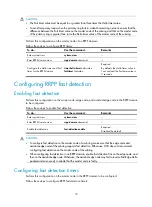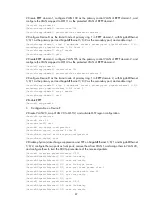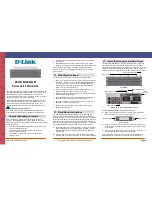
75
•
Device A, Device B, Device C and Device D form primary ring 1, and Device B, Device C and
Device E form subring 2.
•
Device A is the master node of primary ring 1, with GigabitEthernet 1/0/1 as the primary port and
GigabitEthernet 1/0/2 the secondary port.
•
Device E is the master node of subring 2, with GigabitEthernet 1/0/1 as the primary port and
GigabitEthernet 1/0/2 the secondary port.
•
Device B is the transit node of primary ring 1 and the edge node of subring 2, and GigabitEthernet
1/0/3 is the edge port.
•
Device C is the transit node of primary ring 1 and the assistant-edge node of subring 1, and
GigabitEthernet 1/0/3 is the edge port.
•
Device D is the transit node of primary ring 1, with GigabitEthernet 1/0/1 as the primary port and
GigabitEthernet 1/0/2 the secondary port.
Figure 21
Network diagram for intersecting rings configuration
Configuration procedure
1.
Configuration on Device A
# Create VLANs 1 through 30, map these VLANs to MSTI 1, and activate the MST region configuration.
<DeviceA> system-view
[DeviceA] vlan 1 to 30
[DeviceA] stp region-configuration
[DeviceA-mst-region] instance 1 vlan 1 to 30
[DeviceA-mst-region] active region-configuration
[DeviceA-mst-region] quit
# Disable physical state change suppression and STP on GigabitEthernet 1/0/1 and GigabitEthernet
1/0/2, configure the two ports as trunk ports, and assign them to VLANs 1 through 30, and configure
them to trust the 802.1p precedence of the received packets.
[DeviceA] interface gigabitethernet 1/0/1
[DeviceA-GigabitEthernet1/0/1] undo link-delay
[DeviceA-GigabitEthernet1/0/1] undo stp enable
[DeviceA-GigabitEthernet1/0/1] port link-type trunk
[DeviceA-GigabitEthernet1/0/1] port trunk permit vlan 1 to 30
[DeviceA-GigabitEthernet1/0/1] qos trust dot1p
[DeviceA-GigabitEthernet1/0/1] quit
















































